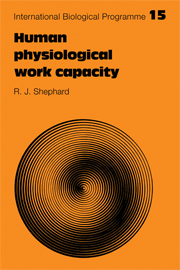Book contents
- Frontmatter
- Contents
- Foreword
- Preface
- 1 Introduction
- 2 Sampling and population studies
- 3 Methods for the measurement of physical fitness, working capacity and activity patterns
- 4 Climate, season and local geography
- 5 Socio-economic status and working capacity
- 6 Working capacity and constitution
- 7 The physical working capacity of the athlete
- 8 The growth of working capacity
- 9 Age and working capacity
- 10 Epilogue
- IBP Human Adaptability section publications
- References
- Index
4 - Climate, season and local geography
Published online by Cambridge University Press: 20 May 2010
- Frontmatter
- Contents
- Foreword
- Preface
- 1 Introduction
- 2 Sampling and population studies
- 3 Methods for the measurement of physical fitness, working capacity and activity patterns
- 4 Climate, season and local geography
- 5 Socio-economic status and working capacity
- 6 Working capacity and constitution
- 7 The physical working capacity of the athlete
- 8 The growth of working capacity
- 9 Age and working capacity
- 10 Epilogue
- IBP Human Adaptability section publications
- References
- Index
Summary
In this chapter, we shall look first at some general effects of climate, season and local geography upon patterns of physical activity and associated fitness levels. We shall then consider in more detail the problems encountered by both indigenous peoples and recent immigrants when working in extremes of heat and cold, and finally will examine briefly the influence of circadian rhythms on working capacity and human activity.
Influences upon physical activity patterns
Climate
Extremes of heat, cold, heavy rain and drought can all modify physical fitness and working capacity by causing changes in the range of habitual activity.
A harsh climate, whether desert heat (Roberts, 1970) or arctic cold (Shephard, 1975a), may demand vigorous physical activity for mere survival. Game and other sources of food may be in very short supply, dictating the need for a nomadic life-style; there are then added energy costs involved in the daily transporting of personal possessions (including children) and the regular building of temporary nocturnal shelters. Lee (1972a) has estimated that African families of the! Kung tribe walk 2400 km each year. Mothers carry their children over this distance until they reach the age of four – a significant factor limiting potential birth spacing. In the Botswana region, rainfall varies very widely from season to season and from year to year (Lee, 1972b). Precipitation governs the spatial organization of the community, particularly population density and the area of territory over which one family must wander.
- Type
- Chapter
- Information
- Human Physiological Work Capacity , pp. 47 - 80Publisher: Cambridge University PressPrint publication year: 1978



